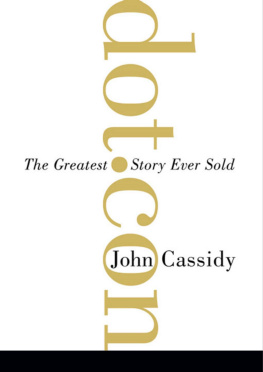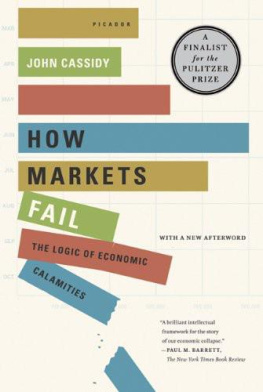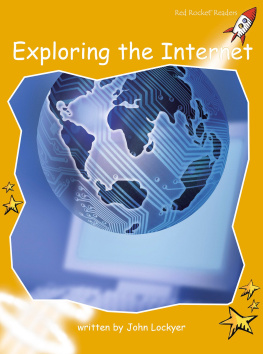John Cassidy - Dot.Con: How America Lost Its Mind and Money in the Internet Era
Here you can read online John Cassidy - Dot.Con: How America Lost Its Mind and Money in the Internet Era full text of the book (entire story) in english for free. Download pdf and epub, get meaning, cover and reviews about this ebook. year: 2009, publisher: HarperCollins e-books, genre: Romance novel. Description of the work, (preface) as well as reviews are available. Best literature library LitArk.com created for fans of good reading and offers a wide selection of genres:
Romance novel
Science fiction
Adventure
Detective
Science
History
Home and family
Prose
Art
Politics
Computer
Non-fiction
Religion
Business
Children
Humor
Choose a favorite category and find really read worthwhile books. Enjoy immersion in the world of imagination, feel the emotions of the characters or learn something new for yourself, make an fascinating discovery.
- Book:Dot.Con: How America Lost Its Mind and Money in the Internet Era
- Author:
- Publisher:HarperCollins e-books
- Genre:
- Year:2009
- Rating:4 / 5
- Favourites:Add to favourites
- Your mark:
- 80
- 1
- 2
- 3
- 4
- 5
Dot.Con: How America Lost Its Mind and Money in the Internet Era: summary, description and annotation
We offer to read an annotation, description, summary or preface (depends on what the author of the book "Dot.Con: How America Lost Its Mind and Money in the Internet Era" wrote himself). If you haven't found the necessary information about the book — write in the comments, we will try to find it.
John Cassidy: author's other books
Who wrote Dot.Con: How America Lost Its Mind and Money in the Internet Era? Find out the surname, the name of the author of the book and a list of all author's works by series.
Dot.Con: How America Lost Its Mind and Money in the Internet Era — read online for free the complete book (whole text) full work
Below is the text of the book, divided by pages. System saving the place of the last page read, allows you to conveniently read the book "Dot.Con: How America Lost Its Mind and Money in the Internet Era" online for free, without having to search again every time where you left off. Put a bookmark, and you can go to the page where you finished reading at any time.
Font size:
Interval:
Bookmark:
I would like to thank everybody who helped me to write Dot.con. At HarperCollins: David Hirshey, Jeff Kellogg, Cathy Hemming, Adrian Zackheim, Cindy Achar. At The New Yorker: David Remnick, Dorothy Wickenden, Pam McCarthy, Henry Finder, John Bennet, and, especially, Cressida Leyshon. At the Wylie Agency: Andrew Wylie and Jeffrey Posternak. Thanks also to: Katherine Zoepf, for checking facts and compiling the footnotes; Greg Kyle, at Pegasus Research, for compiling the figures in the appendix; Alice Rose, for inspiring the title. The material in this book is drawn from a combination of firsthand reporting, government economic statistics, SEC filings, corporate press releases, contemporary newspaper and magazine stories, research reports, academic periodicals, and books. Whenever practical, I have tried to indicate the relevant sources. All the opinions expressed are my own.
This book is dedicated to my parents, John and Julie Cassidy.
Ever get the feeling youve been cheated?
Johnny Rotten
One of the strange things about history is how certain periods from long ago can seem recent, while some events that just happened, relatively speaking, can appear ancient. As these words are being written, President George W. Bush has declared war on terrorism, and American warplanes are heading for Central Asia. Suddenly the Cold War, with its attendant undercurrent of fear, feels a lot closer, while the carefree 1990s seem like a distant age. It is too early to judge the ultimate historic significance of the terrorist attacks that were carried out on the World Trade Center and the Pentagon on September 11, 2001, but one thing is clear: they changed Americas view of itself. The belief in U.S. military and economic invulnerability, which grew stronger by the year during the 1990s, until it was taken for granted by many, has been violently undermined. In the wake of the attacks, Americas attention has shifted from the secondary human concerns that dominated during the 1990s boom (saving for old age,getting rich) to the primary matters of human survival (staying safe, providing a livelihood for ones family).
Already, it is hard to fathom that just a couple of years ago many intelligent Americans believed that the marriage of computers and communications networks had ushered in a new era of permanent peace and prosperity. Depending on which Wall Street or Silicon Valley guru you listened to, the Internet was the most revolutionary development since the electric dynamo, the printing press, or the wheel. The most striking manifestation of this thinking was the extraordinary prices that people were willing to pay to invest in Internet companies. In nearly every sector of the economy, entrepreneurs, many barely out of college, were rushing to establish online firms and issue stock on the Nasdaq, which was heading upward at a vertiginous rate. Names like Marc Andreessen, Jerry Yang, and Jeff Bezos were being uttered with awe.
In March 1999, Priceline.com, an Internet company that operated a site on the World Wide Web where people could name their price for airline tickets, was preparing to do an initial public offering (IPO). In order to introduce Priceline.coms executives to Wall Street analysts and fund managers, Morgan Stanley, the investment bank that was managing the IPO, hired a ballroom at the Metropolitan Club, at 1 East Sixtieth Street, a fitting location. The Metropolitan, which John Pierpont Morgan founded and Stanford White designed, is a lavish remnant of a previous gilded age. Four stories high, its white marble exterior is fronted by six Roman columns and an ornate cornice. After the guests had picked at their lunch, Richard S. Braddock, Priceline.coms chairman and chief executive, told them that his firm had the potential to revolutionize not just the travel business, but automobile sales and financial services, too. This was a grand claim from a start-up that had been in business for less than a year andemployed fewer than two hundred people, but nobody in the room queried Braddocks presentation.
By the standards of the time, Priceline.com had impressive credentials. Jay S. Walker, the companys founder, was a Connecticut entrepreneur who had already made one fortune by peddling magazine subscriptions in credit card bills. Braddock was a former president of Citicorp, and Priceline.coms board of directors included Paul Allaire, a former chairman of Xerox Corporation, N. J. Nicholas Jr., a former president of Time Inc., and Marshall Loeb, a former managing editor of Fortune magazine. William Shatner, the actor who played Captain Kirk in Star Trek, had appeared in a series of popular radio ads for the firm. Morgan Stanleys star analyst, Mary Meeker, recently dubbed Queen of the Net by Barrons, the weekly investment newspaper, had helped coach the Priceline.com team for their presentation, and she was sitting in the back of the room as they spoke.
The word on Wall Street was that Priceline.com would follow the path of America Online, Yahoo!, and eBay to become an Internet blue chip. The only question people in the investment community were asking was how much stock they would be able to lay their hands on. Underwriters reserved Internet IPOs for their most favored clients. Other investors had to wait until trading started on the open market before they could buy any stock. On the morning of March 30, 10 million shares of Priceline.com opened on the Nasdaq National Market under the symbol PCLN. They were issued at $16 each, but the price immediately jumped to $85. At the close of trading, the stock stood at $68; it had risen 425 percent on the day. Priceline.com was valued at almost $10 billionmore than United Airlines, Continental Airlines and Northwest Airlines combined. Walkers stake in the company was worth $4.3 billion.
Airlines like United and Continental own valuable terminals, landing slots, and well-known brand namesnot to mention their planes. Priceline.com owned some software, a couple of powerful computers, and an untested brand name. Despite this disparity, few on Wall Street were surprised by Priceline.coms IPO. Such events had become an everyday occurrence. The New York Times didnt think the story merited a mention on the front page of the next days edition and instead relegated it to the business section. It doesnt matter what these companies do or how they are priced, David Simons, an analyst at Digital Video Investments, told the paper. Each new Internet IPO is nothing more than red meat to the mad dogs. Penny Keo, a stock analyst at Renaissance Capital, saw things differently. We like Pricelines business model, she said.
This was an interesting statement. Priceline.com started operating on April 6, 1998. By the end of the year it had sold slightly more than $35 million worth of airline tickets, which cost it $36.5 million. That sentence bears rereading. Here was a firm looking for investors that was selling goods for less than it had paid for themand as a result had made a trading loss of more than a million dollars. This loss did not include any of the money Priceline.com had spent developing its Web site and marketing itself to consumers. When these expenditures were accounted for, it had lost more than $54 million. Even that figure wasnt what accountants consider the bottom line. In order to persuade the airlines to supply it with tickets, Priceline.com had given them stock options worth almost $60 million. Putting all these costs together, the company had lost more than $114 million in 1998.
How could a start-up retailer that was losing three dollars for every dollar it earned come to be valued, on its first day as a public company, at more than United Airlines, Continental Airlines, and Northwest Airlines put together? To answer that question we must investigate what the nineteenth-century British historian Charles Mackay called the madness of crowds. Few investors, acting in isolation, would buy stock in a company like Priceline.com. To be willing to take such a risk, people needed to see others doing the same thingand see them making money doing it. This is exactly what happened. Investors who bought stock in early Internet companies like Netscape, Yahoo!, and Amazon.com made a lot of moneyat least for a while. None of these firms could boast much in the way of revenues when they went public, let alone profits, but that didnt seem to matter. Seeing what was happening, other people started to buy Internet stocks, and other types of stocks too, not because the underlyingcompanies were good businesses with solid earnings prospects, but simply because stock prices were going up. As history has repeatedly demonstrated, this is the point when a rising market turns into a speculative bubble.
Font size:
Interval:
Bookmark:
Similar books «Dot.Con: How America Lost Its Mind and Money in the Internet Era»
Look at similar books to Dot.Con: How America Lost Its Mind and Money in the Internet Era. We have selected literature similar in name and meaning in the hope of providing readers with more options to find new, interesting, not yet read works.
Discussion, reviews of the book Dot.Con: How America Lost Its Mind and Money in the Internet Era and just readers' own opinions. Leave your comments, write what you think about the work, its meaning or the main characters. Specify what exactly you liked and what you didn't like, and why you think so.










